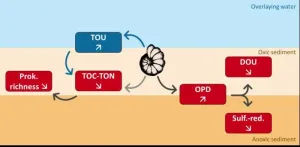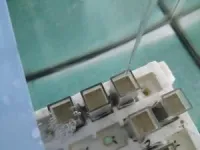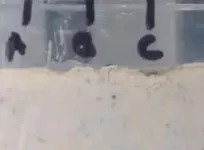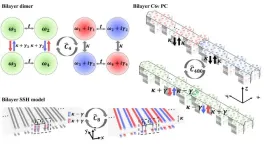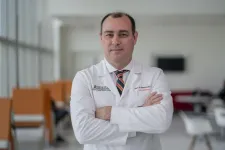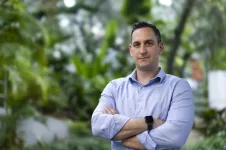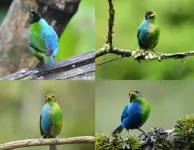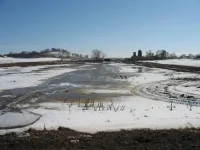(Press-News.org) Dr. Dewi Langlet, a scientist at the Evolution, Cell Biology and Symbiosis Unit at the Okinawa Institute of Science and Technology (OIST), studies foraminifera, single-cell organisms with shells made of calcium carbonate. He and his collaborators have shown for the first time that the burrowing of single-celled organisms in marine ecosystems affects oxygen distribution and bacterial diversity in sea sediments. Their findings have been published in the journal Biogeosciences.
Foraminifera are mostly marine organisms that have been around for about 550 million years and when they die, their shells accumulate on the ocean floor and become part of the ocean sediment.
While they are microscopic organisms (between 63 and 500 micrometers in diameter) they are still ‘big’ compared to other single-cell organisms, with each species having a unique shape. They live and are abundant in all marine sediments, from estuaries to the deep sea.
Geologists have studied them for a long time because their shells can fossilize, but we do not know much about their biology. Dr. Langlet is trying to understand how they move in the sediment and how this affects the entire sea bottom ecosystem.
Bioturbation occurs when organisms disturb the sediment by moving in it and creating burrows, which affects the mixing of the sediment particles. This affects the size of the particles, regulates water through the sediment, and changes the chemical composition of the sediment.
Bioturbators, often referred to as ‘tillers of the soil’, play an important role in determining nutrient availability and providing food and shelter for many species. They also significantly contribute to many natural processes and outputs, collectively known as ‘ecosystem services’, that we humans greatly benefit from.
“Typically, at the surface of marine sediments oxygen is consumed by the organisms living in the sediment, and gradually the oxygen decreases as you go deeper. We asked the question, 'Does foraminifera affect the oxygen distribution in the sediment when they move or when they create burrows?'” said Dr. Langlet.
“It was hypothesized for a long time that they affect the oxygenation and chemistry of the sediment, but it was never proven because they are so small that their impact is very difficult to detect.” Previous studies have shown that larger multicellular organisms, such as worms, increase the oxygen penetration in the sediment by creating burrows, but this has never been shown for single-cell organisms such as foraminifera.
By creating burrows, foraminifera are engineering their entire ecosystem at a small-scale, allowing them to live deeper in the sediment where there is usually no oxygen. The scientists show that through their burrowing, they affect not just oxygenation but organic matter, bacterial diversity and ultimately how much food there is available in the sediment.
Finding enough foraminifera for the experiment was a challenge. “For a big aquarium, we need to study many foraminifera and it is very time consuming to isolate them to know how many there are, so we must work with small amounts of sediment. It’s all about miniaturization, working with small systems,” Dr. Langlet explained.
The effect that these organisms have on their environment is relatively small because of their very small size, so the scientists needed very precise instruments, called microsensors, to accurately measure the distribution of oxygen in the sediment.
In his lab at OIST, Dr. Langlet worked with tiny sediment samples, each about 1 cm wide, placed in a tank filled with water. He added foraminifera to these samples and every few days measured how the oxygen levels changed at different depths. He found that with their burrows, foraminifera allow oxygen to go deeper into the sediment, increasing the amount of oxygen by 15 to 20 per cent. This causes a decrease in organic matter which leads to reduced bacterial abundance, which ultimately decreases the movement of oxygen from the water into the sediment.
Dr. Langlet’s future research will explore the interactions between foraminifera and other organisms of similar size, as well as larger animals such as worms. “Are foraminifera interacting with these worm-created burrows? Could their presence potentially amplify the effects of these burrows?” he asks. These questions will guide his future investigations.
END
Underwater architects: The ‘burrowing effect’ of foraminifera on marine environments
Impact of single-cell organisms on sediment oxygen levels and bacterial diversity measured for the first time.
2023-12-12
ELSE PRESS RELEASES FROM THIS DATE:
A scheme for realizing nonreciprocal interlayer coupling in bilayer topological systems
2023-12-12
The exchange of energy and environment is inevitable in any physical system, so non-Hermitian systems that can be described by non-Hermitian Hamiltonians are ubiquitous. There are two kinds of non-Hermitian Hamiltonians, describing nonreciprocal systems with anisotropic coupling, also referred to as nonreciprocal coupling, and gain-loss systems. Three physicists won the Nobel physics prize for their discovery of topological phases and transitions in 2016. Recently, an emerging interplay of topological photonics and non-Hermitian photonics has ...
Combination immunotherapy produces high response rate in early results of Sylvester trial targeting high-risk follicular lymphoma
2023-12-12
DOWNOADABLE VIDEO
MIAMI, FLORIDA (EMBARGOED UNTIL MONDAY, DEC. 11, 2023 AT 8:45 P.M. ET) – Researchers conducting a Phase 2 clinical trial at Sylvester Comprehensive Cancer Center at the University of Miami Miller School of Medicine say a new combination of antibody therapies produced a ‘surprisingly high’ response rate in patients with high-risk follicular lymphoma, a type of non-Hodgkin lymphoma.
Based on these initial findings – reported in an oral presentation at the 65th ASH Annual Meeting and Exposition in San Diego, California, Dec. 9-12 – the research team plans to expand the number of trial participants ...
Multicenter study at Sylvester, other academic centers shows CAR-T cell therapy safe, effective even for high-risk patients
2023-12-12
DOWNLOADABLE VIDEO IS AVAILABLE HERE
MIAMI, FLORIDA (EMBARGOED UNTIL MONDAY, DEC. 11, 2023, AT 8:45 PM ET) – CAR-T cell therapy is a safe and effective treatment for diffuse large B-cell lymphoma (DLBCL), even for patients regarded as high risk due to comorbidities.
That’s the conclusion of a five-year analysis of results from the U.S. Lymphoma CAR-T Cell Consortium, a group of 17 academic cancer centers in the U.S. Their findings will be presented at the American Society of Hematology’s 2023 annual meeting in San Diego, Dec. 9-12.
“CAR-T has caused a paradigm shift in the treatment of patients with diffuse large B-cell ...
Clinical trial proves that the ketogenic diet is effective at controlling polycystic kidney disease
2023-12-12
(Santa Barbara, Calif.) — It’s official: The ketogenic diet proved to be effective at controlling polycystic kidney disease (PKD) in the first randomized controlled clinical trial of ketogenic metabolic therapy for PKD.
“I’m really happy about these clinical trial results,” said UC Santa Barbara biologist Thomas Weimbs, whose lab was part of an international collaboration to investigate the effect of the fasting response known as ketosis on the cysts that are the hallmark of the disease. “We now have the first evidence in humans that the cysts really don’t like ...
New drug helps narrow racial survival disparity in patients with acute myeloid leukemia
2023-12-12
SAN DIEGO – Non-Hispanic Black patients with acute myeloid leukemia (AML) are living longer, now that new therapies are available, according to a study presented by researchers from the University of Pennsylvania Perelman School of Medicine and Penn Medicine’s Abramson Cancer Center at the 65th American Society of Hematology (ASH) Annual Meeting and Exposition (Abstract 955).
In the past, the standard treatment for AML, a cancer that affects the blood and bone marrow, was intensive chemotherapy. Unfortunately, many older patients were ineligible ...
Scientific community: Ukraine may have lost 20% of its pre-war scientific research capacity
2023-12-12
Ukraine may have lost about 20% of its scientific research capacity — time directly spent by scientists on research activities — as a consequence of the Russia-Ukraine war. The findings, published in Humanities & Social Sciences Communications, also suggest that over 17% of scientists who were research active in Ukraine before the war may have left the scientific research sector by December 2022.
Since the full-scale Russian invasion of Ukraine began in February 2022, there has been disruption to many sectors of the Ukrainian economy, including the Ukrainian scientific research sector. However, it has so far proved difficult to quantify many of the key impacts of the ...
Ukraine has lost 18% of its scientists due to the war
2023-12-12
Until the early morning of February 24th, 2022, Ukrainian scientist Olena Iarmosh did not believe there would be a Russian invasion of Ukraine. Iarmosh grew up and had settled in Kharkiv, her beloved city in Eastern Ukraine and only 40 km away from the Russian border, where she worked for more than 16 years as a lecturer in higher education before fleeing to Switzerland. At approximately 5AM, she awoke to the sounds of bombing, hoping that they were merely the loud sounds of technical maintenance at the local power plant.
“My city looks worse now after the bombing than after two occupations by German troops,” ...
Extremely rare bird captured on film
2023-12-12
A striking and extremely rare half female, half male bird has been spotted by a University of Otago zoologist.
Sesquicentennial Distinguished Professor Hamish Spencer was holidaying in Colombia when an amateur ornithologist John Murillo pointed out a wild Green Honeycreeper with distinct half green, or female, and half blue, male, plumage.
“Many birdwatchers could go their whole lives and not see a bilateral gynandromorph in any species of bird. The phenomenon is extremely rare in birds, I know of no examples from New Zealand ever.
“It is very striking, I was very privileged to see it,” Professor Spencer says.
Photographs of the bird make ...
Study: Extreme rainfall increases ag nutrient runoff, conservation strategies can help
2023-12-12
URBANA, Ill. – Nutrient runoff from agricultural production is a significant source of water pollution in the U.S., and climate change that produces extreme weather events is likely to exacerbate the problem. A new study from the University of Illinois Urbana-Champaign looks at how extreme rainfall impacts runoff and suggests possible mitigation strategies.
“We look at more than a decade of precipitation events in the state of Wisconsin and quantify the increase in nutrient runoff right around the event and at the end of the growing season. Climate ...
The Lancet Oncology: Risk of dying from cancer in some poorer districts of England over 70% higher than wealthy districts, study suggests
2023-12-12
Peer-reviewed / Observational study / People
The Lancet Oncology: Risk of dying from cancer in some poorer districts of England over 70% higher than wealthy districts, study suggests
Analysis of the risk of dying from the most cancers with the largest death toll across the 314 districts in England finds that in 2019 the highest risks were in northern cities such as Liverpool, Manchester, Hull and Newcastle, and in coastal areas to the east of London.
The risk of dying from cancer before 80 years of age ranged from one in ten in Westminster to one in six in Manchester for women, and from one in eight in Harrow to one in five in Manchester ...
LAST 30 PRESS RELEASES:
UMass Amherst chemists develop unique tool for studying RNA
Disappointment alters brain chemistry and behavior
A built-in odometer: new study reveals how the brain measures distance
Stress-related brain signals drive risk of cardiovascular disease in people with depression and anxiety
New details on role of fat transport molecules in Alzheimer’s onset
Study illuminates how an antiviral defense mechanism may lead to Alzheimer’s disease
Spot the males: New gene-editing method could transform mosquito control
AI learns to build simple equations for complex systems
NAU team releases 13 years of detailed U.S. CO2 emissions data
Unveiling how sodium-ion batteries can charge faster than lithium-ion ones
How do childcare tax credits affect children’s long-term health?
Can an electronic nose detect indoor mold?
Do natural disasters have long-term impacts on mortality in older adults?
Modification improves sodium‐ion batteries as an alternative to lithium-ion batteries
Parasports provide a range of benefits for people with cerebral palsy
How does grandparental care affect children’s health?
Why are there so many Nordic mediators?
Young shark species more vulnerable to extinction
Mobile fetal heart monitoring linked to fewer newborn deaths in Tanzania
Bluey’s dad offered professorial chair in archaeology at Griffith University
Beyond small data limitations: Transfer learning-enabled framework for predicting mechanical properties of aluminum matrix composites
Unveiling non-thermal catalytic origin of direct current-promoted catalysis for energy-efficient transformation of greenhouse gases to valuable chemicals
Chronic breathlessness emerging as a hidden strain on hospitals
Paleontologists find first fossil bee nests made inside fossil bones
These fossils were the perfect home for ancient baby bees
Not everyone reads the room the same. A new study examines why.
New research identifies linked energy, immune and vascular changes in ME/CFS
Concurrent frailty + depression likely boost dementia risk in older people
Living in substandard housing linked to kids’ missed schooling and poor grades
Little awareness of medical + psychological complexities of steroid cream withdrawal
[Press-News.org] Underwater architects: The ‘burrowing effect’ of foraminifera on marine environmentsImpact of single-cell organisms on sediment oxygen levels and bacterial diversity measured for the first time.
